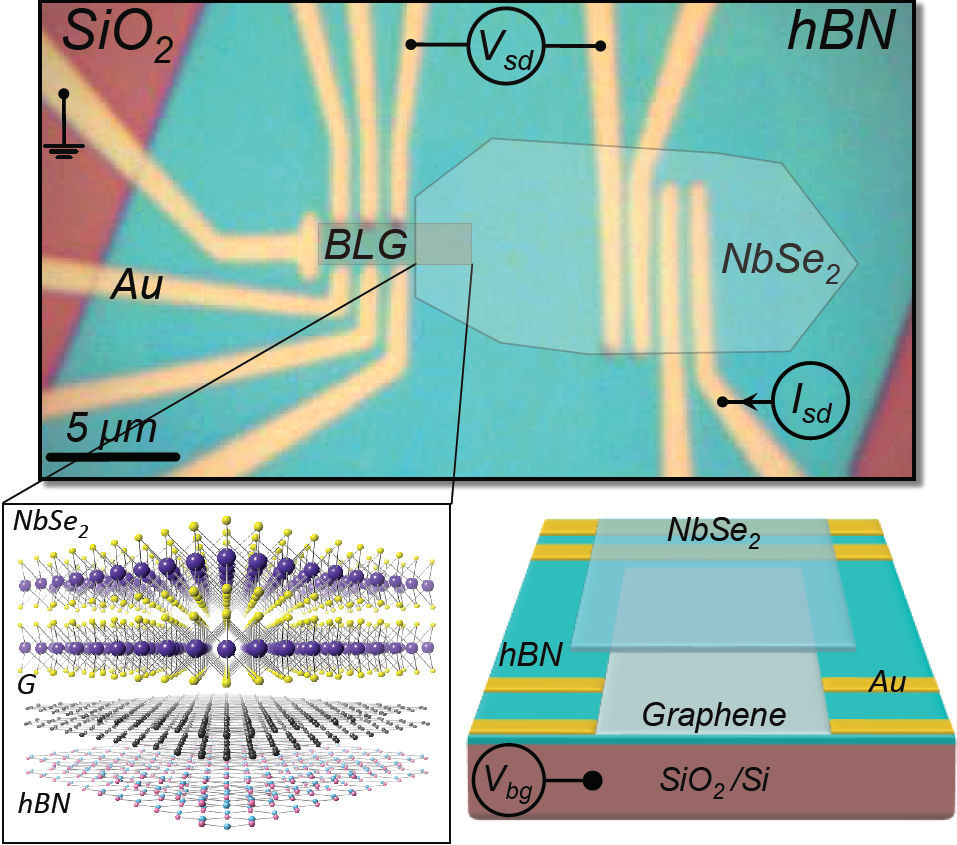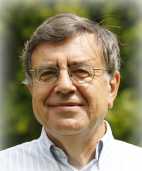Mirrored interband Andreev reflections on van der Waals contacts between graphene and niobium selenide
In the February issue of the authoritative scientific journal Nature Physics , an article by our leading scientist Konstantin Borisovich Efetov was published. Online version of the article Specular interband Andreev reflections at the van der Waals interfaces between graphene and NbSe2
This article reflects the results of studying the properties of contacts between superconductors and graphene, the experiment proved the possibility of making high-quality contacts between graphene and superconductors, which in turn will bring researchers closer to creating new electronic devices and, possibly, a quantum computer. Of course, this goal is in the long run, but researchers have already managed to observe an interesting fundamental effect - the mirror Andreev reflection.
It is noteworthy that the experiment itself was conducted by Dmitri Efetov, the son of Konstantin Borisovich.
Konstantin Borisovich has already written for our blog an expert opinion on high-temperature superconductivity , where this effect was described in a fairly popular format, this publication sparked active discussion and approval from the community. And this time we also asked Konstantin Efetov to write for us a press release on the published article.
')

An international group of researchers with the participation of a scientist working within the framework of the grant at NITU “MISiS” published important work on the study of the properties of contacts between superconductors and graphene. Interest in the creation and study of such nanostructures is due to the search for new opportunities for electronics arising from the use of quantum properties of matter, as well as attempts to create a quantum computer. It is important to note that the effect, first observed in the work, has a deep fundamental nature and broadens the understanding of the most interesting effects of “nanophysics”. An article about this paper was published in the latest issue of Nature Physics.
Electrons incident from a normal metal to a superconductor are reflected back precisely in the form of holes (the missing electron is usually described as a quasiparticle-hole). This remarkable prediction was first made by the outstanding Russian physicist A.F. Andreev in 1964
Observation of this effect became possible with the development of nanotechnology and attracted great attention from both experimenters and theorists, since superconducting structures are used in electronic devices. Currently, the creation of arrays of superconducting islands is the main direction in the construction of a quantum computer.
New opportunities have arisen with the advent of a two-dimensional graphene material consisting of carbon atoms. For his creation, A. Geim and K. Novoselov received in 2010 the Nobel Prize. Due to its extraordinary properties, graphene has gained immense popularity in recent years, and is regarded as one of the most promising materials for semiconductor electronics.
In 2007, the Dutch scientist K. Beenacker remarked in his theoretical work that Andreev reflection could in this case significantly change its properties, so that the holes would be reflected not backwards, but mirrored as the light reflected in the mirror. This effect arises due to the two-band electronic spectrum of graphene. These two zones are in contact at certain points, and if the electron energy is close enough to these points, it is possible that the incident electron is in the upper zone, and the reflected hole is in the lower one. That is what should have led to a mirror image.
Although the contacts between graphene and superconductors were fabricated several years ago, the observation of mirror Andreev reflection was not an easy task, since extremely pure graphene systems were required. The creation of high-quality contacts between graphene and superconducting niobium selenide and ultrapure graphene samples made it possible in the end to observe a mirror Andreev reflection.
The experiment was conducted mainly at Columbia University in New York with support from Princeton University and the National Institute of Materials Science in Japan. The experimental data were compared with the results of a theoretical calculation carried out by Konstantin Efetov (project leader in the framework of the Top-100 program) during his work at NITU “MISiS”. Good agreement between theory and experiment led to the conclusion that it is precisely the Andreev mirror reflection that is observed.
This article reflects the results of studying the properties of contacts between superconductors and graphene, the experiment proved the possibility of making high-quality contacts between graphene and superconductors, which in turn will bring researchers closer to creating new electronic devices and, possibly, a quantum computer. Of course, this goal is in the long run, but researchers have already managed to observe an interesting fundamental effect - the mirror Andreev reflection.
The reflection of electrons from the boundary between a normal metal and a superconductor is called "Andreevsky" in honor of the outstanding Soviet physicist Alexander Andreev, who predicted this behavior of an electron between an ordinary metal and a superconductor.
It is noteworthy that the experiment itself was conducted by Dmitri Efetov, the son of Konstantin Borisovich.
Konstantin Borisovich has already written for our blog an expert opinion on high-temperature superconductivity , where this effect was described in a fairly popular format, this publication sparked active discussion and approval from the community. And this time we also asked Konstantin Efetov to write for us a press release on the published article.
Konstantin Borisovich Efetov is the Scientific Director of the project “Collective Phenomena in Quantum Matter” at NITU “MISiS” within the framework of a grant to support scientific research of the TOP 5-100 program. Kb Efetov is an outstanding reviewer of the American Physical Society, Director of the Institute of Theoretical Physics at the 3rd Ruhr University Bochum in Germany, honorary member of the American Physical Society , lead researcher of three projects funded by the German Ministry of Scientific Research, author of over 170 publications, winner of the French Blaise Pascal Prize founded by the French Landau-Weizman Government and Research Prize, established by the Weizman Institute in Israel. Konstantin Efetov is an "outstanding reviewer of the American Physical Society." This Award is given for notable contribution to reviewing articles in such journals as Physical Review Letters, Physical Review, Reviews of Modern Physics and others.
')

An international group of researchers with the participation of a scientist working within the framework of the grant at NITU “MISiS” published important work on the study of the properties of contacts between superconductors and graphene. Interest in the creation and study of such nanostructures is due to the search for new opportunities for electronics arising from the use of quantum properties of matter, as well as attempts to create a quantum computer. It is important to note that the effect, first observed in the work, has a deep fundamental nature and broadens the understanding of the most interesting effects of “nanophysics”. An article about this paper was published in the latest issue of Nature Physics.
Electrons incident from a normal metal to a superconductor are reflected back precisely in the form of holes (the missing electron is usually described as a quasiparticle-hole). This remarkable prediction was first made by the outstanding Russian physicist A.F. Andreev in 1964
 | Konstantin Borisovich Efetov Scientific leader of the project "Collective phenomena in quantum matter" NITU "MISiS" |
Observation of this effect became possible with the development of nanotechnology and attracted great attention from both experimenters and theorists, since superconducting structures are used in electronic devices. Currently, the creation of arrays of superconducting islands is the main direction in the construction of a quantum computer.
New opportunities have arisen with the advent of a two-dimensional graphene material consisting of carbon atoms. For his creation, A. Geim and K. Novoselov received in 2010 the Nobel Prize. Due to its extraordinary properties, graphene has gained immense popularity in recent years, and is regarded as one of the most promising materials for semiconductor electronics.
And what if using graphene instead of ordinary metals in contacts with superconductors? How will the electrons incident from graphene on the surface of a superconductor be reflected?
In 2007, the Dutch scientist K. Beenacker remarked in his theoretical work that Andreev reflection could in this case significantly change its properties, so that the holes would be reflected not backwards, but mirrored as the light reflected in the mirror. This effect arises due to the two-band electronic spectrum of graphene. These two zones are in contact at certain points, and if the electron energy is close enough to these points, it is possible that the incident electron is in the upper zone, and the reflected hole is in the lower one. That is what should have led to a mirror image.
Although the contacts between graphene and superconductors were fabricated several years ago, the observation of mirror Andreev reflection was not an easy task, since extremely pure graphene systems were required. The creation of high-quality contacts between graphene and superconducting niobium selenide and ultrapure graphene samples made it possible in the end to observe a mirror Andreev reflection.
The experiment was conducted mainly at Columbia University in New York with support from Princeton University and the National Institute of Materials Science in Japan. The experimental data were compared with the results of a theoretical calculation carried out by Konstantin Efetov (project leader in the framework of the Top-100 program) during his work at NITU “MISiS”. Good agreement between theory and experiment led to the conclusion that it is precisely the Andreev mirror reflection that is observed.
The results of the work were reported by one of the authors of the work, Dmitry Efetov (Massachusetts Institute of Technology) at the conference "Superconductivity and Magnetism", held at NITU "MISiS" in September 2015 as part of the Top 5-100 program.The main goal of the experiment was to observe the fundamental effect. But, as is often the case, the development of the technologies necessary for conducting a study paves the way for the creation of new instruments. At present, high hopes for building qubits (basic elements in a quantum computer) are placed on “transmones” —Josephson contacts connected in parallel with capacitors. Josephson contacts are superconductors interconnected by a dielectric or a normal metal. For example, semiconductor wires, which provide good contact with superconductors, are taken as connecting material in the construction of qubits. The possibility of making high-quality contacts between graphene and superconductor, achieved in the work, makes it possible to manufacture transmones based on superconductors connected by graphene.
Source: https://habr.com/ru/post/390439/
All Articles